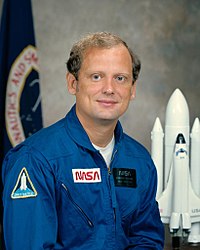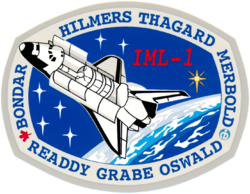Norman Thagard
| Norman E. Thagard | |
 Norman E. Thagard | |
| Astronaut | |
|---|---|
| Tillstånd | Tagit avsked |
| Född | 3 juli 1943 |
| Tid i rymden | 140 dagar, 13 timmar, 24 minuter |
| Urvalsgrupp | Astronautgrupp 8 |
| Uppdrag | STS‑7, STS‑51‑B, STS‑30, STS‑42, Sojuz TM‑21, STS‑71 |
| Uppdragsemblem | |
Norman E. Thagard, född 3 juli 1943 är en amerikansk astronaut uttagen i astronautgrupp 8 den 16 januari 1978.
Rymdfärder
Källor
”Biographical Data” (på engelska) (PDF). NASA. februari 1996. https://www.nasa.gov/wp-content/uploads/2016/01/thagard_norman.pdf?emrc=334cc6. Läst 5 maj 2024.
Media som används på denna webbplats
STS-42 Mission Insignia
Mission patch for the STS-7 mission.
STS-71 Mission Insignia
The STS-71 crew patch design depicts the orbiter Atlantis in the process of the first international docking mission of the Space Shuttle Atlantis with the Russian Space Station Mir. The names of the 10 astronauts and cosmonauts who flew aboard the orbiter are shown along the outer border of the patch. The rising sun symbolizes the dawn of a new era of cooperation between the two countries. The vehicles Atlantis and Mir are shown in separate circles converging at the center of the emblem symbolizing the merger of the space programs of the two space faring nations. The flags of the United States and Russia emphasize the equal partnership of the mission. The joint program symbol at the lower center of the patch acknowledges the extensive contributions made by the Mission Control Centers (MCC) of both countries. The crew insignia was designed by aviation and space artist, Bob McCall, who also designed the crew patch for the Apollo Soyuz Test Project (ASTP) in 1975, the first international space docking mission.
The STS-30 patch depicts the joining of NASA's manned and unmanned space programs. The sun and inner planets of our solar system are shown with the curve connecting Earth and Venus symbolizing the shuttle orbit, the spacecraft trajectory toward Venus, and its subsequent orbit around our sister planet. A Spanish caravel similar to the ship on the official Magellan program logo commemorates the 16th century explorer's journey and his legacy of adventure and discovery. Seven stars on the patch honor the crew of Challenger. The five-star cluster in the shape of the constellation Cassiopeia represent the five STS-30 crewmembers - Astronauts David Walker, Ronald Grabe, Norman Thagard, Mary Cleave and Mark Lee - who collectively designed the patch.
The official crew patch for the Russian Soyuz TM-21 mission, which delivered the EO-18 crew to the space station Mir.
NASA Astronaut Norman E. Thagard







